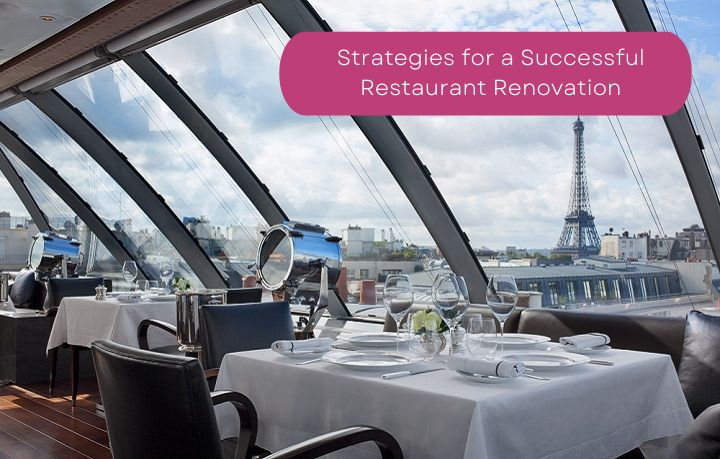Renovating a restaurant can be an exciting but complex endeavor. Whether you’re looking to refresh your establishment’s aesthetics, upgrade its functionality, or adapt to changing trends, a well-executed restaurant renovation can breathe new life into your business and attract a broader customer base. To ensure your restaurant renovation is a success, following a well-thought-out strategy is essential. Here are some key strategies to consider for a successful restaurant renovation.

Table of Contents
Define Your Goals and Budget
Before embarking on a restaurant renovation, defining your goals and establishing a clear budget is crucial. Identify the changes you want to make, whether creating a more modern atmosphere, expanding your seating capacity, or enhancing the kitchen’s efficiency. Having a well-defined scope will help you allocate funds and resources more efficiently.
Work with a Professional Design Team
Hiring a professional design team is a crucial step in the renovation process. Architects, interior designers, and contractors with experience in restaurant design can help you create a functional and visually appealing space. If you are looking for an eye-catching centerpiece for your restaurant, you might want to look into fireplaces from Stonewoods – London Fire Places. Collaborate closely with your design team to ensure your vision aligns with practicality, local building codes, and safety regulations.
Maintain Your Brand Identity
While updating your restaurant’s appearance is essential, it’s equally important to maintain your brand identity. Your renovation should reflect the unique character and ambiance that your customers associate with your establishment. Balancing a fresh look with a consistent brand identity will help keep loyal patrons while attracting new ones.
Choose Quality Materials and Equipment
Investing in high-quality materials and equipment is essential for a long-lasting renovation. Restaurant spaces endure significant wear and tear, so durable and easy-to-maintain materials are a wise choice. High-quality kitchen equipment will enhance efficiency and ensure the consistent quality of your menu items.
Plan for Efficiency
Efficiency should be a top priority in your restaurant renovation. Optimize your kitchen layout, storage spaces, and service areas to streamline operations. This can result in quicker service, lower labor costs, and better customer satisfaction. Consider energy-efficient appliances and lighting to reduce operational costs and minimize your environmental footprint.
Compliance with Codes and Regulations
Ensure your renovation project complies with local building codes, health regulations, and safety standards. Neglecting these can lead to costly delays and potential legal issues. Engage with experts familiar with these requirements who can guide you through the permitting process.
Timing is Key
Minimize disruption to your business by carefully planning the timing of your renovation. Consider quieter periods, seasonal fluctuations, and the estimated duration of the project. Effective timing will help you maintain revenue streams and avoid alienating your regular customers.
Communication and Transparency
Keep your staff and customers informed about your renovation plans. Transparency is key to maintaining trust and managing expectations. Provide regular updates on your progress, and assure customers that the result will enhance their dining experience.
Marketing and Promotion
Use your renovation as an opportunity to generate excitement and buzz. Launch a marketing campaign to build anticipation among your existing and potential customer base. Showcase concept sketches, behind-the-scenes videos, and teasers to engage your audience and create a sense of anticipation.
Monitor Progress and Adapt
Throughout the renovation process, closely monitor the progress and be prepared to adapt to unexpected challenges. Staying flexible and responsive to changes will help ensure the project’s success and reduce the likelihood of costly delays.




